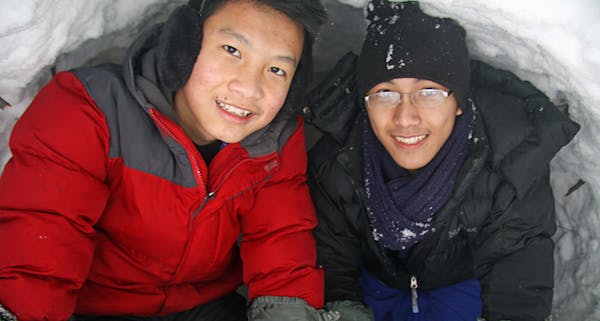On a quiet city street on Monticello's south side, brash honking fills the air like a stadium roar. It pulls visitors forward from the handful of parking spaces on Mississippi Drive, where they eagerly close car doors, tug on hats and mittens, and hustle across Swan Park, a narrow easement between homes. Here, a fenced area faces the Mississippi and an undulating sea of white along its shore.
Trumpeter swans' long necks bob up and down with the frenzied excitement of dogs dancing for dinner. It's mealtime, and they know it. At 10:30 every morning, Jim Lawrence doles out close to a ton of corn from plastic bins and scatters some across the ice for a flock of close to 2,000 trumpeter swans.
"It is like a bunch of sixth-graders playing runaway trumpets in a band," joked Lawrence, who lives along the shore and took over the 90-minute feeding chore for his late wife, Sheila, who died of cancer in 2011 and was affectionately dubbed "the Swan Lady."
She and Jim moved to the riverside residence on Mississippi Drive in 1984, and the first swans showed up two years later. They were part of a Three Rivers Park District (then Hennepin County Parks) effort to reintroduce swans to Minnesota. The waterfowl liked this particular spot on the river because it stayed ice-free with a nuclear power plant a few miles upriver, had gentle water away from the main channel and was close to farm fields for salvaging corn. Or the birds could simply enjoy the corn the Lawrences provided.
"Sheila used to say [the honking] was music to her ears," Lawrence said. But the enjoyment in seeing them each winter goes beyond the sound and spectacle of so many swans. It's a chance to watch these highly social creatures as they groove in family groups, mingle, romance their mates and generally show off. Party time for birds
"Winter is the perfect time," said Madeleine Linck, wildlife technician with Three Rivers Park District. "It's like a singles bar out there."
The easiest behavior to spot is groups of about four to six swans that suddenly seem to gather, honking and drawing closer until forming a circle, where they do their best to puff out chests, flap wings and honk. They seem to be saying "You want a piece of this? Huh? Huh?" but Linck explained that's typically their version of family bonding, especially between mates who use it as a gesture of triumph. Younger swans often mimic that behavior. Others can be seen dishing up a little alpha attitude as they flap wings, honk, give a poke or chase fellow swans lining up as suitors.
"Swans are beautiful, graceful creatures," Linck said, "but they'll be aggressive."
There's apparently a lot on the line when you mate for life. Swan pairs spend most of the year on their own, reigning like a king and queen over a single lake or wetland, raising an average of four to six babies a year.
As winter freezes their lakes and access to vegetation, and snow covers farm fields with leftover corn, the birds gather by open water for winter. Ideally, the swans would fly to warmer states, but the re-established flocks don't have the genetic coding and parental guidance to do that. Only a few hundred have figured out to fly as far as Arkansas and have begun doing that annually, Linck said.
With a growing swan population now up to 6,000 in Minnesota — plus a few coming from Ontario — they are spreading out in new locations. Linck has heard about swans wintering on the Otter Tail and Pelican rivers in the Fergus Falls area, on Park Rapids' Fishhook River and on the St. Croix River near Hudson, Wis., plus a few other scattered locations.
Still, roughly a third of Minnesota's swan population flocks to Monticello for the winter. They use the river like a runway, taxiing downward, their large wings (each 4 feet wide) arced and their large black feet ready to hit first. Monticello is for lovers
Weighing close to 35 pounds and ranking as North America's largest waterfowl, they need space to land and take off. They also spook easily. The fence at Monticello's Swan Park was built to keep people at a distance comfortable for the swans. It's a nice idea to bring binoculars, cameras and spotting scopes to get close-up views, but there is plenty to watch regardless.
For the gray-feathered cygnets, these winter gatherings are usually the first time they get to mingle with fellow swans outside their family group.
Winter also is when the swans begin courting. Even longtime mates wisely use the time around Valentine's Day to renew their bonds. Observers will see these couples rubbing necks or swimming side by side.
With thousands of swans to watch, it's wise to dress warm and plan to stay a while — especially for anyone who enjoys wildlife photography. Lucky (and patient) shutterbugs may be able to catch the classic swan pose: a pair nuzzling beak to beak, curved necks forming an elegant heart — one of nature's sweetest scenes.
Lisa Meyers McClintick is a freelance travel writer based in St. Cloud. She blogs at www.10000Likes.com.

Live: Minnesota United at Charlotte FC. Follow on Gameview.
Jameson Taillon comes off the injured list and helps the Cubs beat the Marlins 8-3
T-wolves take NBA's best defense into series vs. Suns, but can it stop Durant-Booker-Beal trio?

